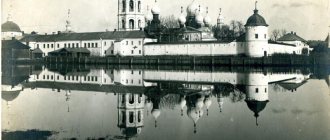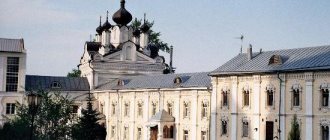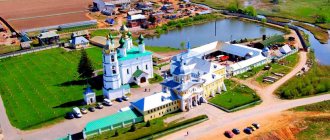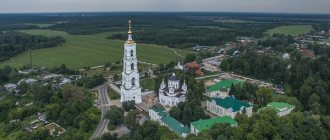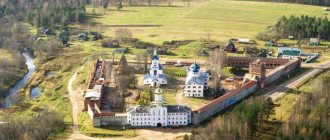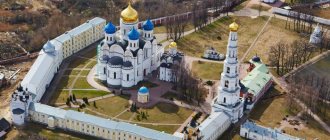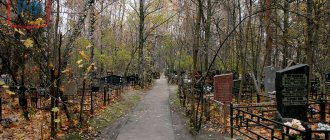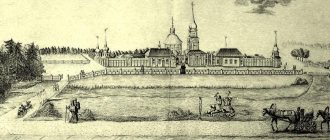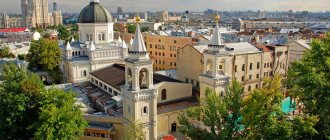The Nikolo-Perervinsky Monastery in Moscow, which today stands in Pechatniki, according to legend, was founded around the time of the historical Battle of Kulikovo, however, documentary evidence dates us back to 1623.
It was then that in one of the decrees of the autocrat Mikhail Fedorovich, a wooden church in the name of St. Nicholas the Wonderworker was mentioned and the small brethren of the monastery were listed, including the abbot and two ancient elders. True, in the chronicle of the 1570s one can read that for some reason the local monastery stands “in the wilderness.”
History of the monastery
According to legend, the Orthodox monastery was founded during the Battle of Kulikovo. It was located several miles from the city and was famous for its silence and solitude. From the high left bank of the Moscow River there was an excellent view of the domes of Moscow churches standing in the distance.
The first evidence of the Perervinsky monastery dates back to 1623. Records of the small wooden church of St. Nicholas and the abbot and two elders living there were preserved in an ancient palace document.
By the 50-60s of the 17th century, Rus' had recovered from the severe consequences of the Time of Troubles, so stone churches began to be erected in the Nikolo-Perervinsky monastery, as in other monasteries in Moscow. The monastery reached its greatest prosperity at the end of the 17th century, when Patriarch Adrian decided to use it as a summer residence.
In the 1770s, a seminary was opened here, and some time later the first two-story building was erected for seminarians. Another remarkable page in the history of the monastery is connected with Catherine II. Going on her famous trip to Crimea, the Empress made a stop at this monastery.
Nikolo-Perervinsky Monastery against the backdrop of the Moscow River
The influence of the monastery on the spiritual life of Moscow grew year by year. Future priests were trained here, and in the 18th and 19th centuries several Moscow chapels were attached to the monastery. At the beginning of the last century, the Nikolo-Perervinskaya monastery had stone churches and solid residential buildings. It was surrounded on three sides by a green front garden. To the south there was an apple orchard, and to the north there was a large cattle yard, behind which stood a pharmacy, a hospital and a monastery hotel.
With the advent of Soviet power, the monastery was not immediately liquidated. In 1928, the brethren were disbanded, but church services in St. Nicholas and Iveron Cathedrals took place until 1940. At first, the former monastery territory was used for warehouses. But in 1948, a metal stamping plant was organized in the Church of St. Nicholas, and then a factory for the production of children's toys.
During the period when religious buildings served as workshops, iconostases and liturgical utensils were lost, frescoes were painted over and floors were destroyed. Due to the work of the galvanizing shop, the brickwork and vaults of the cathedrals were severely damaged, and their appearance was distorted by various outbuildings.
For a long time, no repairs were made to the monastery buildings, so the roofs, window openings and ceilings turned out to be dilapidated. Only the lower part of the monastery bell tower was in a better position, and only because it housed the offices of the authorities.
View of the monastery from the Moskva River
Divine services in the monastery were resumed in 1991. At this time, all the buildings were owned by the Stankokonstruktsiya enterprise. Two years later, the territory was completely transferred to the church.
The ancient buildings looked terrible, so parishioners and volunteers began to raise funds and began restoring the dilapidated shrine.
LiveInternetLiveInternet
Sunday, March 25, 2021 11:57 + in quotation book Nikolo-Perervinsky Monastery is a former monastery in Moscow on the banks of the Moskva River, which has the status of the Patriarchal Metochion. “Take a break! Do not be afraid of your name, for God will not allow you to be interrupted!” Metropolitan Platon (Levshin)
This small and very beautiful monastery is known much less than Donskoy or Novodevichy, but only because it is not in the city center and getting to it is inconvenient, either on your own or by car.
The size of its territory is such that it is four times larger than the Sretensky Monastery, but in turn five times smaller than the Novodevichy Monastery.
The Pererva district is located in the southeast of the capital, on the low left bank of the Moscow River.
This name was fixed a long time ago, several centuries ago, S.I. Ozhegov’s dictionary interprets the word “break” as “tearing, dividing in two.”
According to legend, the Moscow River here bent in an intricate arc and made a revolution in its flow, going in the direction of the village of Kolomenskoye. Streams of water continually overflowed the low meadow, interrupting it in different directions. They were called “breaks.”
“...A gray-haired old man came to earth, built a wooden cell and began to pray. Soon people began to come to him, prayed with him and built a temple together.” This is how, according to legend, the history of the monastery begins - with the construction of the wooden church of St. Nicholas the Wonderworker, after whom the monastery would later be named.
From the announcement on the wall of the monastery, it is clear that taking photographs here without a blessing is not recommended. This was a couple of years ago. Now it is impossible to take photographs here, it is strictly prohibited,
Saint Nicholas the Wonderworker, especially revered in Rus', is a historical figure; he was born in the city of Patara (in Lycia), his parents, Theophanes and Nonna, descended from noble families.
In Rus', Nicholas the Wonderworker was known as the good patron of sailors, children, and all those who suffered, who performed many merciful deeds. In 1087, his relics were transported by the crusaders to the Italian city of Bari.
So the name for the monastery was not chosen by chance; it was Nicholas the Wonderworker who was destined to become one of the most revered saints in the Eastern and Western Church. In Moscow alone, in honor of the saint, according to the “Index of Moscow Churches” by M. Aleksandrovsky, by 1915 58 churches were consecrated.
In the first few centuries of its existence, the monastery was completely abandoned and served more as a prison than a haven for believers.
In addition, the monastery was constantly robbed, since at that time it was located far from Moscow. Repeatedly, the enemy who was marching on Moscow found himself at the walls of the monastery; the Tatars and Lithuanians plundered the monastery and devastated it.
In 1591, Khan Kazy-Girey stood with the horde near the walls of the monastery, and in 1610, False Dmitry II with his army. At the beginning of the 17th century. the rebel peasants of Ivan Bolotnikov plundered the monastery, and then the “liberators” of the monastery - warriors of the Streltsy regiments - did the same.
During the Time of Troubles, the Nikolo-Perervinskaya monastery was plundered and pretty much destroyed. Its restoration began only when Alexei Mikhailovich, who ascended the throne, assigned the Iverskaya Chapel, located at the Resurrection Gate of the Kremlin, to the monastery.
The miraculous icon of the Iveron Mother of God was first located in the monastery of St. Nicholas the Old on Nikolskaya Street (some Moscow scholars consider this monastery to be the forerunner of St. Nicholas-Perervinsky), and then it was transferred to the Assumption Cathedral. Later a chapel was built for her.
Being located on the busy Red Square at that time, it provided a very significant income. Another source for restoration was the monastery courtyard between the current streets - Maroseyka and Lubyanka, which was rented out.
After the revolution in 1927, the chapel was closed, and in 1934 it was demolished along with the Resurrection Gate, because these buildings interfered with demonstrations taking place on Red Square.
For some time the icon disappeared. It is now believed that it is in the Tretyakov Gallery. In 1994, the new Iveron Chapel was consecrated at the restored Resurrection Gate, in which they placed the new Iveron Icon of the Mother of God, painted on Mount Athos.
The most significant building today on the territory of the Nikolo-Perervinsky Monastery is the Cathedral in the name of the Iveron Mother of God. It was erected between 1904 and 1908 in the Russian-Byzantine style. The author of the project is architect Petr Alekseevich Vinogradov. On the day of the consecration of the temple, a miraculous icon was delivered from the Iveron Chapel.
The Cathedral of the Iveron Icon of the Mother of God in its dimensions was second only to the Cathedral of Christ the Savior. Its length was 36 m, width - 34, and height with domes - 53 m.
The second church of the monastery is the five-tiered stone Assumption Church. The main entrance was located on its first level, and the monastery sacristy was located on the second. The church itself in the name of the Dormition of the Mother of God was on the third level, and the fourth and fifth were occupied by a striking clock and a bell tower, respectively.
St. Nicholas Cathedral with an internal church in the name of Sergius of Radonezh was erected between 1696 and 1700. A gallery-porch was built between the temple and the bell tower.
In the period from 1733 to 1735, construction of a baroque church in the name of the Tolga Mother of God was underway. The place where it was installed was the walls of the monastery fence above the Water Gate leading directly to the river.
If you go through the monastery and exit that gate over there, you can get into the monastery garden and see the Moscow River below.
Initially, the Nikolo-Perervinsky Monastery stood right next to the water, then the river receded, and the monastery was surrounded by gardens. Unlike many other monasteries near Moscow, Perervinsky remained wooden for a long time. The beginning of stone construction here is associated with the name of the tenth Patriarch of Moscow and All Rus', Adrian.
Elected patriarch in 1690 against the will of Tsar Peter the Great, Adrian firmly stood for old customs and opposed foreign innovations. Adrian was not afraid to appear with the icon in his hands in the dungeon where Peter tortured the archers. Enraged by the pastoral call for mercy, the tsar kicked the patriarch out. As a sign of silent protest, Adrian moved to the Nikolo-Perervinsky Monastery.
The peculiarity of the Perervinsky monastery was that it was not the melody of the bell that sounded above it, but the sound of the bell. Beat, or riveted - special iron boards that were used until they learned how to cast bells. They remembered the blows again when Peter urgently needed copper for his cannons. Bells were removed from churches, and bells decorated with Peter the Great's monogram were sent in return.
By the way, Alexei Mikhailovich’s concern for the monastery was explained by the fact that it offered the most impressive view of the beloved royal residence in Kolomenskoye. The road there was specially detoured, through Kozhukhovo and Pererva, so that a magnificent panorama of the Kolomna Palace, rising on the steep right bank of the Moscow River, would gradually open up before travelers.
The peace of the monastery, far from Moscow, was short-lived. In 1877, the first dam was built in Pererva, which was to become part of a huge structure - the Pererva hydroelectric complex, which also consisted of locks and a hydroelectric power station.
Not all of us have the opportunity to see the monastery in real life, so I invite you to visit it VIRTUALLY. It’s better to watch in FULL SCREEN MODE by clicking on the button with four arrows. CLICK ON THE PICTURE.
source
Series of messages “Virtual excursions to churches”:
Part 1 - Church of the Faithful Mary in VIENNA (Maria-True Kirche, Piaristenkirche Maria Treu) Part 2 - Wooden church in Usce Gorlicke ... Part 14 - Virtual excursion to the Church of the Holy Apostles Peter and Paul at the Jauza gate Part 15 - Virtual tour of the Church of the Resurrection of Christ in Minsk Part 16 - Virtual tour of the Nikolo-Perervinsky Monastery. Part 17 - Virtual excursions to the holy places of Jerusalem Part 18 - Virtual tour to the Epiphany Cathedral with the Baptismal Church of St. Basil Part 19 - Virtual excursion to the St. Michael Athos Hermitage.
Tags:
Virtual excursions
Cited 31 times Liked by: 77 users
Like share
0
Like
- 77
I liked the post - Quoted
- 0
Saved
- Add to quote book
- 0
Save to links
Liked77
0
The legend of the underground passage
Legends about the existence of dungeons connecting the two banks of the Moscow River have existed for a long time. According to them, a secret passage led from the Church of the Kazan Mother of God in Kolomenskoye to the Nikolo-Perervinsky Monastery. It was dug so that the king and members of the royal family could hide on the other side, in the monastery, in the event of a riot or unrest.
Local residents knew well about the dungeon. They showed the passage to the famous archaeologist and historian Ignatius Yakovlevich Stelletsky, who spent many years studying old Moscow and looking for underground hiding places.
At the end of the 1920s, Steletsky discovered two corridors leading from the altar of the Kazan Church to the basement. But in 1930, research work had to be suspended, since, according to the architect of the Kolomenskoye Museum-Reserve, excavations under the temple threatened to collapse the building. To date, the secret of the dungeon of the Nikolo-Perervinsky monastery remains unsolved.
View of the monastery from the south
Temples, buildings and monastic landmarks
The central place in the monastery complex is occupied by the majestic St. Nicholas Church, which is often called “Old St. Nicholas”.
The single-domed cathedral was erected in 1696-1700 on the site of three small churches. In memory of these ancient churches, the upper part of the cathedral was dedicated to St. Nicholas, and the throne in the bell tower was dedicated to the Dormition of the Mother of God. The warm lower part of St. Nicholas Cathedral was consecrated in honor of Sergius of Radonezh. It consists of the temple itself, the altar and a spacious refectory, the center of which is supported by a massive pillar.
A slender bell tower adjoins the temple from the southeast. The tall building is composed of a four-tiered quadruple and an octagonal structure, where the bells are located. And the bell tower is crowned with a neat gilded dome with a cross.
To the east of the old cathedral stands the huge Iversky Temple or the new cathedral. It was built in 1905-1908 by the architect Pyotr Alekseevich Vinogradov to house the famous image of the Iveron Mother of God.
The spacious temple can accommodate up to 3,000 believers at a time. Sixteen domes are painted sky blue and are clearly visible from the surrounding streets, as well as from the Pererva station.
Cathedral of the Iveron Icon of the Mother of God
Above the gate leading to the monastery, there is a gate temple dedicated to the Tolga Icon of the Mother of God. It appeared in 1733, when the monastery brethren was led by Abbot Varlaam. Originally there were two gates under the temple. However, only one has survived to this day - the “water ones”, which received this name because the monks used them to fetch water from the river.
Since 1924, the club and canteen of the railway orphanage were located in the gate church. Then the frescoes on the walls were whitewashed, and the temple premises were converted into housing. In the 1950s, a building for the factory was added to the side of the altar. Due to all these changes, the restoration of the gate church took a long time.
Another small church appeared in the monastery quite recently - in 2014. The wooden Church of St. John the Evangelist was built between the monastery’s garden and the bank of the Moscow River. Weddings are occasionally held there, and church services are held once a month.
From the east the monastery is surrounded by a fence. From the north, west and south, the monastery territory is limited by stone buildings of the 18th-19th centuries - patriarchal cells, old and new seminary buildings, bishops' and abbot's buildings.
Cathedral of St. Nicholas the Wonderworker
In the monastery there is a monument to Metropolitan Platon (Levshin), who founded the monastery seminary and wrote the first scientific work dedicated to the history of the Russian Church. On the monument, made by sculptor Anatoly Andreevich Bichukov, the Metropolitan is depicted standing at full height.
Architectural ensemble of the monastery
All this, as well as its appointment as the summer residence of Patriarch Adrian, led to the fact that, starting from the 50s of the 17th century, the Nikolo-Perervinsky Monastery experienced its rapid heyday.
In 1650, a five-tiered stone Assumption Church-bell tower was built, decorated with baroque paintings, gilded stucco moldings and incomparable colored tiles with images of cherubs.
The main entrance was located on its first level, and the monastery sacristy was located on the second. The church itself in the name of the Dormition of the Mother of God was on the third level, and the fourth and fifth were occupied by a striking clock and a bell tower, respectively.
St. Nicholas Cathedral with an internal church in the name of Sergius of Radonezh was erected between 1696 and 1700. A gallery-porch was built between the temple and the bell tower.
In the period from 1733 to 1735, construction of a baroque church in the name of the Tolga Mother of God was underway. The place where it was installed was the walls of the monastery fence above the Water Gate leading directly to the river.
Over time, patriarchal cells, an abbot's building, and a bishop's house appeared on the territory of the monastery, which fit perfectly into the architectural ensemble of the entire monastery.
The most significant building today on the territory of the Nikolo-Perervinsky Monastery is the Cathedral in the name of the Iveron Mother of God. It was erected between 1904 and 1908 in the Russian-Byzantine style. The author of the project is architect Petr Alekseevich Vinogradov. On the day of the consecration of the temple, a miraculous icon was delivered from the Iveron Chapel, which was the second copy from the Athos Iveron Icon of the Mother of God and was brought to Russian soil back in 1699.
Painting of the interior walls began only in 1910. The work was supervised by Vasily Pavlovich Guryanov, a court icon painter who used themes in the plots consistent with the work of Viktor Mikhailovich Vasnetsov. The carved iconostasis was made by I.A. Sokolov, and the golden vestments for him were made by the Zaglotin brothers.
The monastery today
For more than 20 years, the monastery has had the status of a patriarchal metochion. Church services in its churches are held every day: on weekdays at 7.30 and 17.00, and on Sundays and holidays at 8.00 and 16.00. The territory of the monastery is well-groomed and kept clean. Believers and tourists are allowed here any day from morning to evening.
The monastery is engaged in extensive educational activities. It has a Sunday school, a gymnasium named after Metropolitan Plato (Levshin), an Orthodox theater and courses for adults. In addition, a theological seminary operates on the basis of the monastery, where future priests and catechists receive free higher education for five years.
